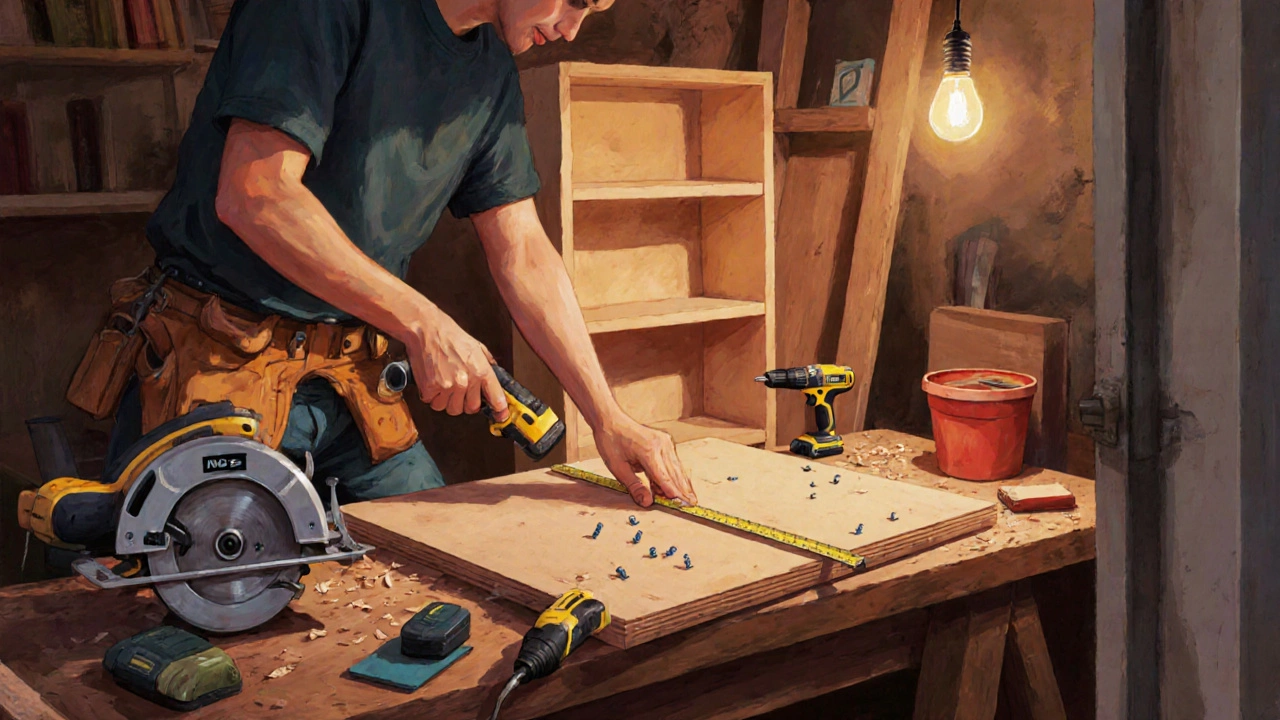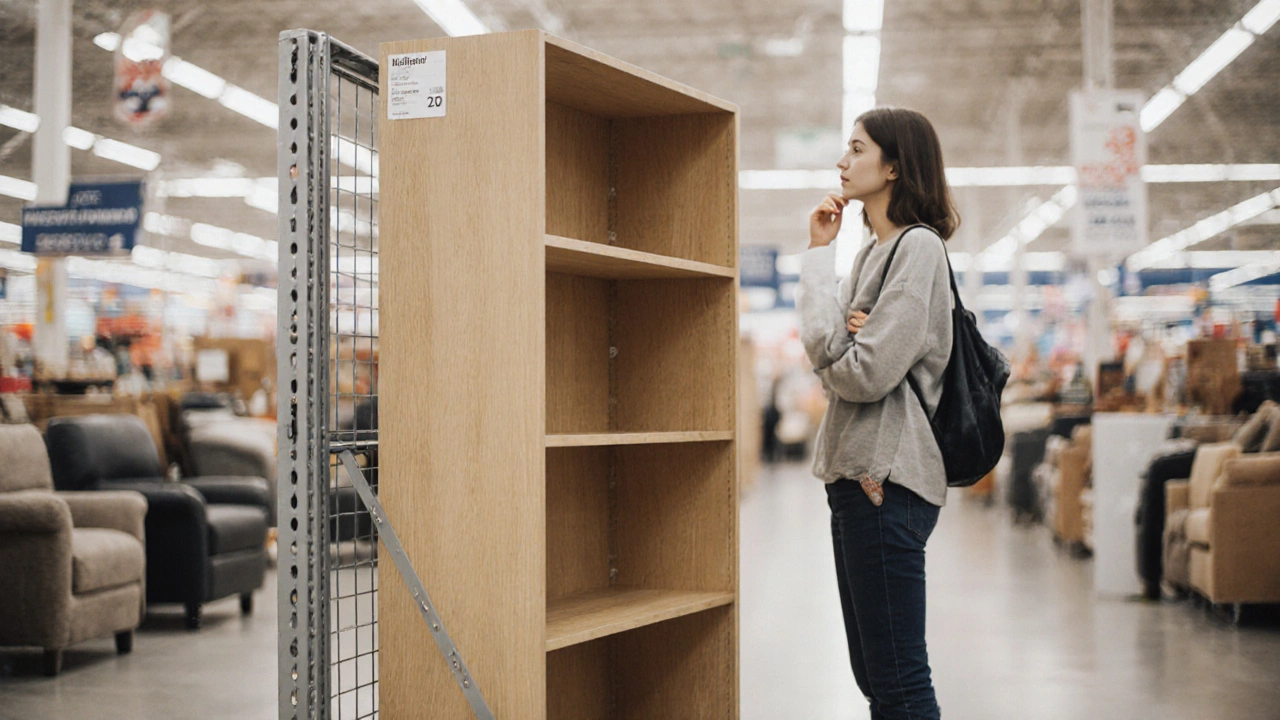Bookshelf Cost Calculator
Calculate Your Bookshelf Costs
Cost Comparison Results
DIY Cost: £0
Ready-Made Cost: £0
Ever stood in the aisle, eyeing a sleek bookshelf and wondered if you could save a few pounds by making one yourself? You’re not alone. The decision to buy or build a bookshelf hinges on budget, skill level, and what you want the piece to look like. Below we break down every cost factor, walk through a simple DIY build, and give you a quick‑look checklist so you can decide on the spot.
Key Takeaways
- Ready‑made bookshelves range from £30 for flat‑pack models to £300+ for solid‑wood designs.
- A basic DIY bookshelf using MDF and standard hardware can be built for £50‑£90, depending on size.
- The biggest hidden costs in a DIY project are tools and finish (paint, varnish).
- If you already own basic tools, DIY usually beats buying for budget‑friendly sizes.
- For premium aesthetics or complex dimensions, buying may still be cheaper than hiring a carpenter.
Understanding the Cost Variables
When you compare a ready‑made bookshelf with a DIY bookshelf, the total price splits into three buckets:
- Materials - wood, panels, screws, finish.
- Tools - drill, circular saw, sander (often already owned).
- Time & expertise - your weekend hours or a carpenter’s labor.
Let’s dive into each.
Materials: From Flat‑Pack to Raw Boards
Most budget‑friendly ready‑made units are flat‑pack particleboard or MDF with a veneer finish. A 5‑shelf unit of that type typically costs £35‑£60. Mid‑range solid‑wood options start around £120 and can climb above £300 for premium walnut or oak.
For a DIY build, the material choices dictate the price:
| Material | Price per sheet (≈2.4m²) | Sheets needed | Total material cost |
|---|---|---|---|
| MDF | £25 | 2 | £50 |
| Plywood | £35 | 2 | £70 |
| Solid pine | £45 | 2 | £90 |
| Solid oak | £80 | 2 | £160 |
Beyond the panels, you’ll need hardware - typically 20‑30mm wood screws (£5‑£8 per pack) and maybe metal brackets (£4‑£6). Finish (paint or clear varnish) adds £10‑£15.

Tools: One‑Time Investment or Existing Gear?
If you already own a power drill, a jigsaw or circular saw, and a sanding block, your out‑of‑pocket cost for tools is essentially zero. For newcomers, a basic drill‑screwdriver set costs about £30, a handheld circular saw £45, and a random‑orbit sander £35. These are one‑off purchases; you’ll recoup them on future projects.
Many local hardware stores also rent tools for £10‑£15 per day, a cheap way to test the waters without buying.
Time, Skill, and the Hidden Price Tag
Building a simple bookshelf takes 4‑6hours for a confident DIYer. If you’re learning as you go, add a couple of hours for measuring, cutting, and sanding. Assigning an hourly value of £12 (average UK weekend wage) turns that into £48‑£72 of “labor cost.”
Buying eliminates labor entirely - you just assemble flat‑pack pieces in 30‑45minutes, which most people value at under £5 of time.
Bottom‑Line Cost Calculator
Here’s a quick formula you can use to decide:
Total DIY Cost = Material Cost + Hardware Cost + Finish Cost + (Tool Rental (if needed) OR Tool Purchase) + (Your Hourly Rate × Build Hours) Total Buy Cost = Retail Price + (Your Hourly Rate × Assembly Time)
Plug in the numbers from the tables above and you’ll see where the break‑even point lies. For a basic 5‑shelf unit:
- MDF DIY: £50 (MDF) + £8 (hardware) + £12 (finish) + £0 (tools owned) + (£12×5h) = £122.
- Flat‑pack buy: £45 (retail) + (£12×0.75h) ≈ £54.
In this scenario, buying is cheaper by about £70. However, if you already have the tools and value $0 for labor, the DIY total drops to ~£70, making it competitive with low‑end flat‑pack options.

When DIY Beats Buying - Real‑World Scenarios
- Custom dimensions. You need a bookshelf to fit a narrow wall niche (e.g., 60cm wide). Off‑the‑shelf units rarely match, so a tailored MDF build may cost less than a specialty retailer’s custom order (£150‑£200).
- Eco‑friendly materials. Using reclaimed pine you already have eliminates material cost entirely - the only spend is hardware and finish.
- Hobbyist satisfaction. If you love sanding, painting, and measuring, the “cost” of enjoyment isn’t captured in dollars but can justify the extra expense.
Cheapest Path Checklist
- Measure the space twice - avoid costly re‑cuts.
- Choose MDF for the lowest material price; upgrade to plywood or solid wood only if aesthetics demand it.
- Use a local hardware store for bulk‑pack screws - they’re cheaper than specialty shop options.
- Check tool rental rates before buying - many stores let you rent a drill for £5 a day.
- Factor in your time at £12‑£15 per hour; if you can finish in under 3hours, DIY often wins.
Frequently Asked Questions
What is the cheapest material for a DIY bookshelf?
MDF sheets are the lowest‑cost option, typically £25 per 2.4m² sheet. For a small 5‑shelf unit you’ll need two sheets, totaling about £50 before hardware and finish.
Do I need a professional to cut the panels?
No. A basic circular saw or a table‑saw at your local DIY store can make straight cuts. If you lack the tool, many stores will cut to size for a small fee (≈£5 per cut).
How much does a ready‑made bookshelf cost on average?
Prices range from £30 for basic flat‑pack units (particleboard or MDF) up to £300+ for solid‑wood, designer pieces. Mid‑range options sit around £120‑£180.
Is it worth renting tools for a one‑off bookshelf?
If you don’t already own a drill or saw, renting can be cheaper than buying. Expect around £10‑£15 per day for a drill and £12‑£18 for a circular saw, bringing the total tool cost under £30.
Can I reuse old furniture wood for a new bookshelf?
Absolutely. Reclaimed wood eliminates material expense and adds character. Just sand it down, check for nails or screws, and apply a fresh finish.
Bottom line: If you already have the basics - a drill, a saw, and a bit of time - building a bookshelf with MDF will usually beat buying the cheapest flat‑pack. If you need a premium look, lack tools, or value speed over savings, a ready‑made unit from an online retailer is the safer bet. Use the checklist and calculator above to plug in your own numbers and make an informed choice.


Write a comment